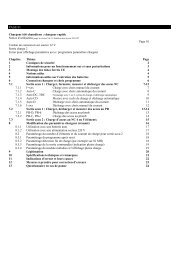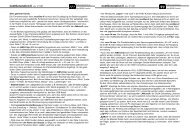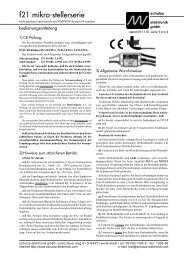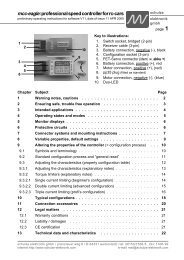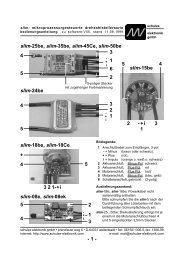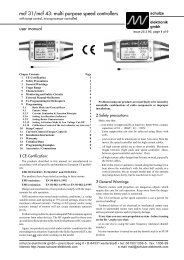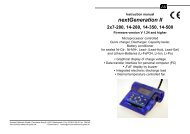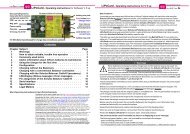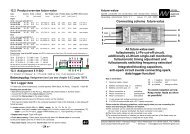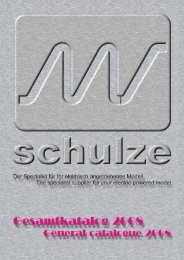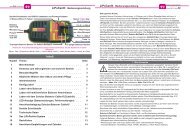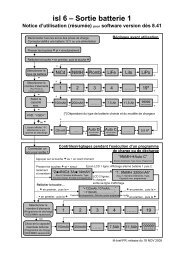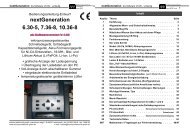nextGeneration II 2x7-280, 14-280, 14-350 - Schulze Elektronik GmbH
nextGeneration II 2x7-280, 14-280, 14-350 - Schulze Elektronik GmbH
nextGeneration II 2x7-280, 14-280, 14-350 - Schulze Elektronik GmbH
Create successful ePaper yourself
Turn your PDF publications into a flip-book with our unique Google optimized e-Paper software.
2<br />
Page Issue 03.10<br />
Fan input<br />
(KEEP CLEAR!)<br />
pos (+)<br />
Battery 1<br />
neg (-)<br />
Batt.1 parameters<br />
and curve screen1<br />
Device parameters<br />
Escape* (break off)<br />
Balancer-Adapterconnector<br />
for<br />
<strong>Schulze</strong><br />
BalAd-SE4-7-<strong>14</strong><br />
or<br />
BalAd-SE4x7<br />
(*) For long time users of the <strong>nextGeneration</strong> 1 the keys<br />
and can be interchanged. See chapter 21.12<br />
<strong>nextGeneration</strong> <strong>II</strong> Firmware V 1.00 and higher<br />
1 General information<br />
Fan input/output<br />
(KEEP CLEAR!)<br />
(+) pos<br />
Battery 2<br />
(-) neg<br />
Batt.2 parameters*<br />
and curve screen2<br />
Cursor movement,<br />
Value selection<br />
Enter (accept) or<br />
Information<br />
about the connected<br />
batteries, charger<br />
characteristics and<br />
car battery volts/amps.<br />
Charge display = duration,<br />
full / empty = blinking light,<br />
deaktivation = chapt. 16.7<br />
8-pin EH male connector to connect<br />
2s - 7s balancing adapters<br />
Congratulations! With the <strong>nextGeneration</strong><strong>II</strong> you have purchased a top of the line product made in<br />
Germany. Reliable SMD technology, outstanding performance and flexibility and last but not least<br />
their easy handling and the new technological features you will have a lot of fun with it. By using the<br />
up-to-date electronic devices (at the moment of the development) the <strong>nextGeneration</strong><strong>II</strong> has become<br />
even more powerful and flexible than all our predecessors. We are convinced that the charger sets<br />
new standards for battery charging technology.<br />
The <strong>nextGeneration</strong><strong>II</strong> requires no maintenance, but needs to be protected against dust and moisture.<br />
Openings in the housing are essential for cooling and must not be blocked!<br />
The <strong>nextGeneration</strong><strong>II</strong> provides best operating comfort and maximum reliability. Using the patented<br />
automatiC charging option for Ni-Cd and Ni-MH batteries, you will notice that the microprocessor<br />
inside will charge you batteries as fast as possible, yet as carefully as necessary (don't be worried<br />
about the relatively high start current of the Ni-MH current calculation automatic).<br />
Additionally you can discharge your batteries, measure their capacity and condition them. Same options<br />
are available for all types of batteries so that also combination programs (charge, discharge or<br />
discharge, charge - up to 5 times) for all battery types are available.<br />
Both outputs may be in use at the same time and independent from each other - when they are not<br />
internally connected in parallel (only possible on next-<strong>14</strong>.XXX).<br />
The graphical LCD (Liquid-Crystal-Display) panel provides a visual representation of the charge voltage<br />
curve relative to time, in addition to the display of charge data in alpha-numeric form.<br />
The unit also enables you to transfer the charge data on-line to a home computer, where it can be<br />
displayed and analysed using the “Akkusoft” software, written by Martin Adler.<br />
In order to make full use of your new charger we strongly recommend you to read the Instruction<br />
Manual page by page and take note of the hints. Although the supplied text is rather long, there is<br />
valuable information in each sentence.<br />
The <strong>nextGeneration</strong><strong>II</strong> series is equipped with a completely silent LED back-lighting graphical screen.<br />
<strong>nextGeneration</strong> <strong>II</strong> Firmware version V 1.00 and higher<br />
Operating<br />
instructions<br />
Issue 03.10, page<br />
Battery 1 and 2 output next-<strong>2x7</strong>-<strong>280</strong> next-<strong>14</strong>-<strong>280</strong> next-<strong>14</strong>-<strong>350</strong><br />
Ni-Cd/Ni-MH batteries<br />
Cell count (@ 1.65V / cell) 1* - 36 cells 1* - 36 cells 1* - 36 cells<br />
max. battery capacity Ni-Cd... 0,1 - 3 Ah 0,1 - 3 Ah 0,1 - 3,5 Ah<br />
dto. with paralleled charge circuits...<br />
...for safe "full" detection<br />
- Ah 0,1 - 6 Ah 0,1 - 7 Ah<br />
max. battery capacity Ni-MH... 0,1 - 6 Ah 0,1 - 6 Ah 0,1 - 7 Ah<br />
dto. with paralleled charge circuits...<br />
...for safe "full" detection<br />
- 0,1 - 12 Ah 0,1 - <strong>14</strong> Ah<br />
Charge currents 0,1 - 6 A 0,1 -6 A 0,1 - 7 A<br />
dto. with paralleled charge circuits - 0,1 -12 A 0,1 - <strong>14</strong> A<br />
Charge power @ 24V about 2 x 150 W 2 x 150 W 2 x 200 W<br />
Charge power @ 12V about<br />
Table for 12 V input voltage:<br />
2 x <strong>14</strong>0 W 2 x <strong>14</strong>0 W 2 x 175 W<br />
@ 1-23 V (~1-15 Ni / 7Li) about 2x 6,0 A 2x 6,0/ 1x 12,0 A 2x 7,0 / 1x <strong>14</strong>,0 A<br />
@ 30 V (~18 Ni / 7 Li) about 2x 4,7 A 2x 4,7 / 1x 9,4 A 2x 5,8 / 1x 11,7 A<br />
@ 40 V (~24 Ni / 9 Li) about 2x 3,5 A 2x 3,5 / 1x 7,0 A 2x 4,4 / 1x 8,8 A<br />
@ 45 V (~27 Ni / 11 Li) about 2x 3,1 A 2x 3,1 / 1x 6,2 A 2x 3,9 / 1x 7,8 A<br />
@ 50 V (~30 Ni / 12 Li) about 2x 2,8 A 2x 2,8 / 1x 5,6 A 2x 3,5 / 1x 7,0 A<br />
@ 60 V (~36 Ni / <strong>14</strong> Li) about<br />
Lead-acid/Li-FePO4,Li-Io,<br />
Li-Po batteries<br />
2x 2,3 A 2x 2,3 / 1x 4,6 A 2x 2,9 / 1x 5,8 A<br />
Power balancing circuits 2 x 7 2 x 7 / <strong>14</strong> 2 x 7 / <strong>14</strong><br />
max. balancing current / cell - 400 mA - 400 mA - 400 mA<br />
Cell count lead batteries 1 - 24 cells 1 - 24 cells 1 - 24 cells<br />
Cell count Li-FePO4 batteries 1 - 16 cells 1 - 16 cells 1 - 16 cells<br />
Cell count Li-Io batteries 1 - <strong>14</strong> cells 1 - <strong>14</strong> cells 1 - <strong>14</strong> cells<br />
Cell count Li-Po batteries 1 - <strong>14</strong> cells 1 - <strong>14</strong> cells 1 - <strong>14</strong> cells<br />
Max. capacity in Ah 0,1 - unlimited 0,1 - unlimited 0,1 - unlimited<br />
Discharge circuits<br />
Cell count Nickel (@ 1,30 V) 1 - 40 1 - 40 1 - 40<br />
Cell count Lithium (@ 4,0 V) 1 - <strong>14</strong> 1 - <strong>14</strong> 1 - <strong>14</strong><br />
Discharge currents 0,1 - 4 A 0,1 - 4 A 0,1 - 4 A<br />
Discharge power up to about 40/2x30**** W 40/2x30**** W 40 / 2x40 W<br />
@ 1-10 V (~1-7 Ni / 2,5 Li) ~ 4,0 (3,0) A 4,0 (3,0) A 4,0 A<br />
@ 20 V (~15 Ni / 5 Li) about 2,0 (1,5) A 2,0 (1,5) A 2,0 A<br />
@ 32 V (~24 Ni / 8 Li) about 0,9 (1,25) A 0,9 (1,25) A 0,9 A<br />
@ 36 V (~27 Ni / 9 Li) about 0,8 (1,1) A 0,8 (1,1) A 0,8 A<br />
@ 40 V (~30 Ni / 10 Li) about 0,75 (1,0) A 0,75 (1,0) A 0,75 A<br />
@ 49 V (~36 Ni / 12 Li) about 0,8 (0,6) A 0,8 (0,6) A 0,8 A<br />
@ 55 V (~40 Ni / <strong>14</strong> Li) about 0,7 (0,55) A 0,7 (0,55) A 0,7 A<br />
47



